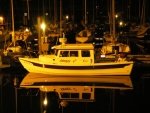There was also the switch from 50 Hz which much of the World still uses, to 60 hz occurred in 1948. Not sure if was the entire county, but S. Cal. Edison where my dad worked for 45 years (From High school lineman, sub station relief operator when at Cal Tech, and retired as VP of Power Supply and Consumer Demand. He was impedimental in the design of the Western Grid. (it appears that just more wire has been added to the old routes theses days.
In Europe we usually had 50 hz 230 volts average on the boat. We had a 4 KW step down transformer, but it would work only on resistive loads--water and cabin heater. Fortunately we had a battery charger which was 50/60 Hz so it worked. We had to run the generator for the freezer/refer. holding plates.
On our cross country drives we see many isolated solar and wind turbine fields, with a central point substation, and new transmission lines coming to these remote areas...

